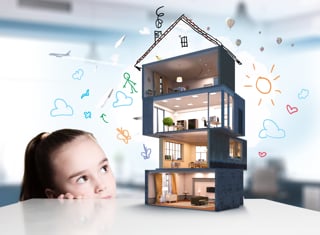Linking transition
in the HVAC industry to sustainability and resilience

Most building technical installations and service systems, including HVAC, are still designed, maintained and/or operated with three things in mind: energy use, comfort requirements and costs. Building installations are metal-intensive; thus, more than 25% of a building's total environmental impact could be attributed to its electrical and mechanical systems. Transforming the HVAC sector is challenging because remanufactured building service systems could run the risk of non-compliance with current standards, and/or because newly produced components are likely to be much more energy-efficient than older ones. The upcoming trend needs to focus on the environmental impact of technological innovations, new business models and new services.
Sustainability in HVAC – Focus on embodied and operational carbon footprint
The HVAC systems in buildings are among the most critical parts of the whole building. Because technical installations are placed out of sight and have very demanding requirements for operation and maintenance, it is no wonder that the focus is on making these building systems as energy-efficient as possible to reduce their embodied and operational carbon footprint. While energy-efficient systems reduce emissions during use, the materials and processes involved in producing HVAC equipment can carry a high carbon cost. Metals like steel and aluminium, refrigerants with high global warming potential, and complex global supply chains all contribute to embodied carbon. To address this, sustainable HVAC strategies now include selecting low-impact materials, designing for durability and ease of maintenance, and prioritising modular, locally sourced systems.
Reducing embodied carbon is essential for achieving true carbon neutrality in buildings and plays a crucial role in life cycle assessments. As regulations evolve, HVAC professionals must consider not just how systems perform, but how they are also made.
There are many parties involved in building systems, such as HVAC manufacturers, designers and engineers, who make sure that the technical installations are well-installed, use smart controls and sensors to optimise heating, cooling and ventilation based on real-time needs, and to provide a good indoor climate for building occupants effortlessly. Facility managers and operators provide regular maintenance to extend the building system's lifespan and efficiency, thus lowering the operational carbon from running the HVAC equipment.
Circularity and transformation in the building systems
The manufacturers and suppliers of building systems are constantly looking for improvements and always intend to design HVAC products for reuse, repair and recycling. Already, many buildings are designed as modular systems with many options for standardisation, which is key for reducing waste.
There is also a clear shift from linear to circular models, i.e. the approach from use-make-dispose towards design-use-reuse-recycle. Also, new schemes are emerging, encouraging manufacturers to re-adapt, re-vitalise or re-update old HVAC components instead of just disposing and installing new systems. Although challenging, manufacturers also consider using sustainable, recyclable or biodegradable materials in manufacturing HVAC.
We are constantly looking into preparing ourselves for the unexpected, and we already know that buildings are one of the key elements.
- Reducing building emissions helps mitigate long-term climate problems. Energy-efficient buildings are also better prepared for grid disruptions or energy price spikes.
- Critical building systems, such as well-designed HVAC systems, are needed to ensure people's comfort and health during extreme weather events.
- Monitoring systems that uphold indoor environmental quality with adaptability features are also required to overcome climate challenges.
- Circularity makes supply chains more robust and less dependent on non-renewable materials.
- In the long term, humanity must focus on extending the limited supply of non-renewable resources.
Is it possible to connect sustainability, circularity, and resilience?
A high-quality, resilient and sustainable indoor environment is a key feature in buildings as it directly impacts building occupants' health, comfort and productivity, even during unexpected events. Optimising the indoor climate provided by low-energy and energy-efficient HVAC systems in buildings can reduce operating costs and lower environmental impact while maintaining performance under unpredictable and intense conditions. It can also reduce dependency on external energy resources, even during system failures.
We can connect sustainability, circularity, and resilience in buildings, as all buildings are designed and built to withstand external stressors – extreme weather-related disruptions, global health-related outbreaks, technological and economic failures and rapid human-caused changes.




